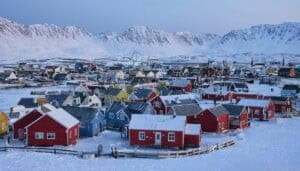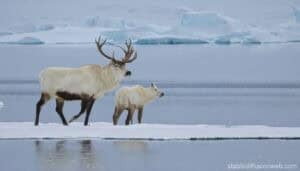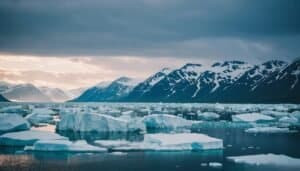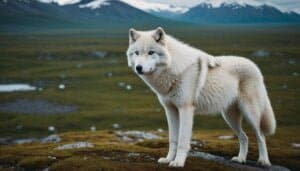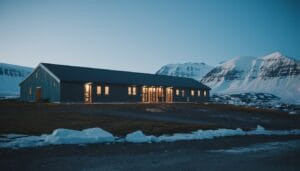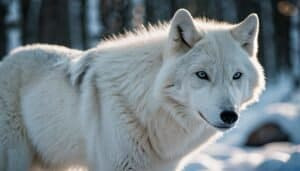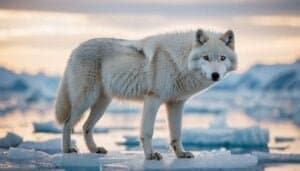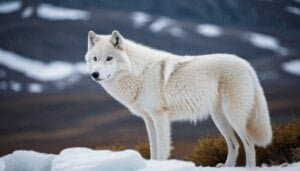Introduction
Arctic wolves play a fascinating and complex role in Arctic tourism, captivating visitors with their elusive presence and majestic demeanor
This article explores various facets of Arctic wolves in tourism, from their attraction for tourists and economic impact on local communities to the marketing strategies employed by tour companies. It delves into tourists’ reactions and the safety measures in place, as well as the ethical and conservation considerations involved in promoting Arctic wolves
Through an in-depth analysis, we aim to provide a comprehensive understanding of how these remarkable creatures are perceived within the context of Arctic tourism
The Role and Attraction of Arctic Wolves in Tourism
Arctic wolves, also known as white wolves, are a subspecies of the gray wolf and are native to the Arctic regions of North America and Greenland. Their striking appearance, with thick white fur and penetrating eyes, makes them a symbol of the wilderness and an intriguing subject for tourists visiting the Arctic
Attraction for Tourists
Arctic wolves are a significant draw for tourists. Many visitors to the Arctic are motivated by the opportunity to see wildlife in its natural habitat, and the Arctic wolf, with its elusive and mysterious nature, is a top attraction
Tourists often embark on guided tours or safaris specifically designed to increase their chances of encountering these majestic animals. The possibility of seeing Arctic wolves in the wild adds a sense of adventure and uniqueness to their travel experience, making it a key selling point for Arctic tourism
Photographers and wildlife enthusiasts are particularly attracted to the Arctic wolf. The opportunity to capture images of these wolves in the dramatic Arctic landscape is a once-in-a-lifetime experience for many. As a result, wildlife photography tours that focus on Arctic wolves are becoming increasingly popular
Economic Impact on Local Communities
The presence of Arctic wolves contributes significantly to the local economies in Arctic regions. Tourism focused on wildlife, including Arctic wolves, provides jobs and income for local communities
Tour guides, hospitality workers, and other service providers benefit from the influx of tourists eager to experience the Arctic wilderness
Moreover, the revenue generated from tourism can be reinvested into conservation efforts, creating a sustainable cycle that benefits both the local economy and the environment. For instance, in areas where Arctic wolf sightings are common, there is often increased funding for wildlife protection programs, which helps to maintain healthy wolf populations and preserve their natural habitats
Marketing Strategies by Tour Companies
Tour companies play a crucial role in promoting Arctic wolves as a key attraction. They employ various marketing strategies to highlight the unique experiences associated with encountering these animals
This includes creating captivating promotional materials that feature stunning images and videos of Arctic wolves, sharing stories of memorable wolf sightings, and emphasizing the rarity and exclusivity of such encounters
Educational components are also often included in tour packages to attract more conscientious travelers. These programs provide insights into the biology and behavior of Arctic wolves, the challenges they face in the wild, and the importance of conservation efforts. By educating tourists, tour companies not only enhance the visitor experience but also foster a deeper appreciation for Arctic wolves and their environment
In addition, tour companies collaborate with local wildlife experts and researchers to ensure that their tours are both safe and respectful of the wolves’ natural behaviors. This responsible approach to wildlife tourism helps to mitigate potential negative impacts on wolf populations and ensures a more sustainable tourism model
Tourists’ Reactions and Safety Measures
The interaction between tourists and Arctic wolves is a highlight of many Arctic excursions, often leaving lasting impressions on visitors. However, managing these encounters requires careful planning and adherence to safety protocols to protect both humans and wildlife
Common Tourist Experiences
Tourists often describe their encounters with Arctic wolves as awe-inspiring and memorable. Many are captivated by the wolves’ grace and power, and the experience often deepens their appreciation for the natural world
Guided tours typically provide narratives that enhance the experience, explaining the behavior, social structure, and survival strategies of Arctic wolves
These encounters can range from distant sightings to more intimate observations, where wolves might approach closer out of curiosity. Such experiences are often shared through personal stories, photographs, and videos, which further promote Arctic tourism and the mystique of these animals
Tourists report a range of emotions during these sightings, from excitement and wonder to a profound sense of connection with nature. For many, seeing Arctic wolves in their natural habitat is a once-in-a-lifetime event that adds significant value to their travel experience
Cultural Differences in Perception
The perception of Arctic wolves can vary greatly among tourists from different cultural backgrounds. In some cultures, wolves are revered as symbols of strength and wilderness, while in others, they may be feared or viewed with suspicion. These cultural differences can influence how tourists react to seeing Arctic wolves and their overall experience
For instance, tourists from regions where wolves are common might be more familiar and comfortable with these animals, while those from areas without wolves might find the experience more thrilling or intimidating
Understanding these cultural nuances is important for tour guides, who can tailor their narratives and safety briefings to better suit their audience
Educational programs provided by tour companies help bridge these cultural gaps, offering a balanced perspective on Arctic wolves and emphasizing their role in the ecosystem. By doing so, they foster a more uniform appreciation and respect for these animals among diverse groups of tourists
Guidelines and Protocols
Ensuring the safety of both tourists and Arctic wolves is paramount. Tour operators implement strict guidelines and protocols to manage interactions and minimize risks. These measures include maintaining a safe distance, avoiding feeding the wolves, and not disrupting their natural behavior
Tour guides are trained to recognize signs of stress or aggression in wolves and to act accordingly. They educate tourists on appropriate behavior, such as remaining calm and quiet, and following instructions at all times
These protocols are essential for preventing negative encounters and ensuring a positive experience for everyone involved
Specific rules might include:
Keeping a minimum distance of 100 yards from the wolves
Using binoculars or zoom lenses for closer views without approaching the animals
Prohibiting direct eye contact, which can be perceived as a threat by wolves
Avoiding loud noises or sudden movements that could startle the wolves
Case Studies of Human-Wolf Interactions
There are numerous case studies highlighting successful and safe interactions between humans and Arctic wolves. These stories often serve as valuable learning tools for improving safety protocols and understanding wolf behavior in the presence of humans
One notable example is the guided tours in Canada’s Arctic regions, where controlled and respectful approaches have allowed tourists to observe wolves up close without disturbing them. These tours often involve collaborations with wildlife biologists who monitor wolf populations and provide insights into their habits and health
Another case study from Greenland involves the integration of local indigenous knowledge in guiding practices. Indigenous guides share traditional understanding of wolf behavior, which complements scientific knowledge and enhances the overall safety and educational value of the tours
Such case studies demonstrate that with proper management and respect for wildlife, it is possible to create meaningful and safe interactions between tourists and Arctic wolves
These positive examples help to promote best practices in wildlife tourism and encourage sustainable and ethical approaches to observing Arctic wolves
Ethical and Conservation Considerations
As Arctic tourism grows, it’s essential to address the ethical and conservation considerations associated with promoting Arctic wolves. Ensuring that tourism activities do not harm the wolves or their environment is critical for sustainable wildlife tourism
Wildlife Conservation Efforts
Conservation efforts are vital in protecting Arctic wolves and their habitats
These efforts include establishing protected areas, monitoring wolf populations, and implementing policies to mitigate the impact of climate change and human activities. Many tour companies collaborate with conservation organizations to support these initiatives, ensuring that tourism contributes positively to the preservation of Arctic wolves
For example, the World Wildlife Fund (WWF) and other conservation groups work to protect Arctic ecosystems, which benefits the entire food chain, including wolves. Tourism revenue often funds these efforts, creating a symbiotic relationship between tourism and conservation
Impact of Human Interaction on Wolves
Human interaction can have both positive and negative impacts on Arctic wolves. While tourism can raise awareness and support for wolf conservation, it can also lead to disturbances in wolf behavior and habitat. Wolves may become habituated to human presence, which can make them more vulnerable to poaching and other threats
Research indicates that frequent human interactions can alter wolves’ natural hunting and breeding behaviors, potentially leading to decreased survival rates. To mitigate these effects, tour operators must enforce strict guidelines that minimize human-wolf interactions and ensure that wolves remain as undisturbed as possible
Habitat Disturbance and Conservation Efforts
Tourism activities can lead to habitat disturbance, which poses a significant threat to Arctic wolves
Infrastructure development, increased human presence, and environmental degradation can disrupt the delicate balance of Arctic ecosystems. Protecting wolf habitats requires careful planning and management of tourism activities to minimize their impact
Conservation efforts focus on preserving large, contiguous areas of habitat that support wolf populations and their prey. This involves regulating tourism activities, such as limiting the number of visitors, restricting access to sensitive areas, and using sustainable practices in tour operations
For example, some Arctic regions have established buffer zones around critical wolf habitats, where human access is restricted. These measures help to ensure that wolves have the space and resources they need to thrive without interference from tourism
Educational Programs for Tourists
Educational programs play a crucial role in promoting ethical and sustainable tourism practices. By educating tourists about Arctic wolves, their behavior, and the challenges they face, tour companies can foster a deeper appreciation and understanding of these animals
These programs often include guided walks, wildlife talks, and interactive exhibits that highlight the importance of conservation
Tourists learn about the ecological significance of Arctic wolves, their role in maintaining the balance of the ecosystem, and the threats they face from climate change and human activities. Such education encourages responsible behavior and supports conservation efforts by creating informed and conscientious visitors
Furthermore, involving tourists in citizen science projects, such as tracking wolf sightings or monitoring environmental changes, can enhance their experience and contribute valuable data to conservation research. This hands-on approach not only enriches the tourists’ understanding but also actively involves them in the preservation of Arctic wolves and their habitats
In conclusion, addressing ethical and conservation considerations is essential for the sustainable development of Arctic wolf tourism. By implementing strict guidelines, supporting conservation initiatives, and educating tourists, it is possible to create a tourism model that benefits both the wolves and the people who come to admire them
Conclusion
Arctic wolves, with their majestic presence and enigmatic allure, play a significant role in the growing field of Arctic tourism
Their ability to attract tourists not only enhances the travel experience but also provides economic benefits to local communities. Tour companies leverage this attraction by employing strategic marketing and offering educational programs that deepen tourists’ understanding and appreciation of these magnificent animals
Tourists’ reactions to Arctic wolves range from awe to a profound sense of connection with nature, influenced by cultural backgrounds and the narratives provided by guides. Ensuring the safety of both tourists and wolves through strict guidelines and protocols is crucial in maintaining positive interactions
Ethical considerations and conservation efforts are paramount in promoting sustainable Arctic wolf tourism. By supporting wildlife conservation, minimizing human impact, and educating tourists, a balance can be struck that protects Arctic wolves while allowing people to experience their beauty and importance within the ecosystem
Arctic wolves are not only a highlight of Arctic tourism but also a symbol of the delicate balance between human activity and wildlife conservation. Responsible tourism practices that prioritize the well-being of these animals and their habitats can ensure that Arctic wolves continue to thrive and enchant visitors for generations to come


